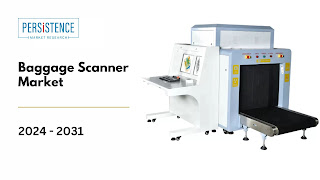Introduction to the Baggage Scanner Market
The baggage scanner market comprises a variety of technologies designed to inspect luggage and cargo for prohibited items, explosives, weapons, and other security threats. These scanners play a critical role in maintaining the safety of passengers, airline staff, and airport personnel while facilitating the smooth flow of goods and people through transportation hubs.
Key Innovations Driving the Baggage Scanner Market
In recent years, the baggage scanner market has witnessed significant advancements aimed at enhancing security effectiveness and operational efficiency. Some of the key innovations driving this market include:
Computed Tomography (CT) Scanning: CT scanning technology offers three-dimensional images of baggage contents, allowing security personnel to inspect items from multiple angles and detect hidden threats more effectively. Compared to traditional X-ray scanners, CT scanners provide higher-resolution images, improving threat detection capabilities and reducing the need for manual inspections.
Automatic Threat Recognition: Artificial intelligence (AI) and machine learning algorithms are increasingly being integrated into baggage scanners to automate threat detection processes. These algorithms analyze scanned images in real-time, automatically identifying suspicious items and alerting security personnel to potential threats. By leveraging AI-driven threat recognition, transportation hubs can enhance security protocols and expedite the screening process.
Dual-Energy X-ray Imaging: Dual-energy X-ray technology enables baggage scanners to differentiate between different materials based on their atomic numbers. This allows scanners to identify a broader range of threats, including explosives, drugs, and weapons, with higher accuracy. By leveraging dual-energy X-ray imaging, transportation hubs can enhance security effectiveness while minimizing the risk of false alarms.
Integration with Security Networks: Modern baggage scanners are designed to seamlessly integrate with airport security networks, enabling real-time data sharing and collaboration among security personnel. This integration enhances situational awareness and facilitates coordinated responses to security incidents, improving overall security effectiveness.
Mobile and Portable Solutions: Portable baggage scanning solutions provide flexibility and scalability, allowing transportation hubs to deploy scanners in various locations based on changing security needs. Mobile scanners enable rapid deployment during peak travel periods or in response to security threats, enhancing the agility and responsiveness of security operations.
For More In-Depth Insights@ https://www.persistencemarketresearch.com/market-research/baggage-scanner-market.asp
Ensuring Safety and Efficiency in Transportation Hubs
The advancements in the baggage scanner market have significant implications for safety and efficiency in transportation hubs:
Enhanced Threat Detection: Advanced imaging technologies and AI-driven algorithms enable transportation hubs to detect a wider range of threats with higher accuracy, enhancing overall security effectiveness and reducing the risk of security breaches.
Improved Operational Efficiency: Automated threat detection and real-time data sharing streamline the baggage screening process, reducing passenger wait times and improving the overall passenger experience. Additionally, the integration of portable and mobile scanning solutions enhances operational flexibility and agility, allowing transportation hubs to adapt to changing security requirements quickly.
Enhanced Passenger Confidence: By strengthening security protocols and minimizing security risks, transportation hubs enhance passenger confidence and satisfaction. The implementation of innovative baggage scanning technologies demonstrates a commitment to ensuring the safety and security of all travelers, fostering trust in the transportation system.
Compliance with Regulatory Standards: Transportation hubs must comply with stringent regulatory standards for airport security. The adoption of state-of-the-art baggage scanning solutions enables hubs to meet regulatory requirements while enhancing security capabilities and maintaining operational efficiency.
Cost Savings and Resource Optimization: By automating threat detection and streamlining security operations, transportation hubs can optimize resource allocation and reduce operational costs. The efficiency gains achieved through innovative baggage scanning technologies contribute to the overall sustainability and competitiveness of transportation hub operations.
Conclusion
The baggage scanner market plays a critical role in ensuring safety and efficiency in transportation hubs. Through continuous innovation and technological advancements, baggage scanners enhance security effectiveness, improve operational efficiency, and instill confidence among passengers and stakeholders. As transportation hubs continue to face evolving security threats, the adoption of state-of-the-art baggage scanning solutions will be essential in safeguarding the integrity of the transportation system and facilitating the seamless flow of goods and people.

Comments
Post a Comment